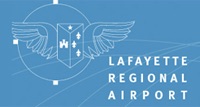Related Research Articles
United Express is the brand name for the regional branch of United Airlines, under which five individually owned regional airlines operate short- and medium-haul feeder flights.

El Paso International Airport is an international airport located four miles (6 km) northeast of downtown El Paso, in El Paso County, Texas, United States. It is the busiest commercial airport in West Texas, and also serves Southern New Mexico and Northern Mexico. It handled 3,904,110 passengers in 2023, with 96,316 aircraft operations.

Lafayette Regional Airport(French: Aéroport régional de Lafayette) is a public use airport two miles (4 km) southeast of Lafayette, in Lafayette Parish, Louisiana, United States. It is owned and operated by the City Parish of Lafayette.
Texas International Airlines Inc. was a United States local service carrier, known from 1940 until 1947 as Aviation Enterprises, until 1969 as Trans-Texas Airways (TTA), and as Texas International Airlines until 1982, when it merged with Continental Airlines. It was headquartered near William P. Hobby Airport in Houston, Texas.

Orlando Executive Airport is a public airport three miles (6 km) east of downtown Orlando, in Orange County, Florida. It is owned and operated by the Greater Orlando Aviation Authority (GOAA) and serves general aviation.

Servicio Aéreo de Honduras S.A. otherwise known as SAHSA Airlines was the national flag carrier airline of Honduras from October 22, 1945, to January 14, 1994. The airline was a subsidiary of Pan American Airways and merged with Transportes Aéreos Nacionales (TAN) to form TAN-SAHSA in November 1991.
Trans International Airlines (TIA) started as a United States supplemental air carrier, at the time the regulatory term for a charter airline. After US airline deregulation in 1979, it also operated scheduled passenger service flying as Transamerica Airlines as well as charter flights during its last decade. Its headquarters were at Oakland International Airport (OAK) in Oakland, California.
Spantax S.A. was a former Spanish leisure airline headquartered in Madrid that operated from 6 October 1959 to 29 March 1988. Spantax was one of the first Spanish airlines to operate tourist charter flights between European and North American cities and popular Spanish holiday destinations and was considered a major force in developing 20th-century mass tourism in Spain. Its popularity and image faded from the 1970s onward when a series of crashes and incidents revealed safety deficits, which, combined with rising fuel costs and increasing competition, resulted in the company facing severe financial difficulties that led to its demise in 1988.

Roswell Air Center is an airport five miles (8.0 km) south of Roswell, in Chaves County, New Mexico, United States.
Grand Bahama International Airport (GBIA) is an international airport in Freeport, The Bahamas. It was privately owned until the government of The Bahamas purchased it in April 29 2021 for one Bahamian dollar, a deal they were able to procure largely due to the devastation from Hurricane Dorian, which almost completely destroyed the airport in 2019. The Bahamian government spent a approximately $1 million on staff severance costs as part of the deal.

Daytona Beach International Airport is a county-owned airport located three miles (5 km) southwest of Daytona Beach, next to Daytona International Speedway, in Volusia County, Florida, United States. The airport has 3 runways, a six-gate domestic terminal, and an international terminal. Daytona Beach is the headquarters of Embry-Riddle Aeronautical University.

Abilene Regional Airport is a public airport located approximately 3 miles (4.8 km) southeast of downtown Abilene, in Taylor County, Texas. The airport is located within the Abilene city limits, and is and owned and operated by the city.
Quebecair was a Canadian airline that operated from 1947 until 1986. Quebecair was headquartered in Saint-Laurent, Quebec, now a part of Montreal.

Northeast Airlines was an American trunk carrier, a scheduled airline based in Boston, Massachusetts, originally founded as Boston-Maine Airways that chiefly operated in the northeastern United States, and later to Canada, Florida, the Bahamas, Bermuda and other cities. It was notably small and unprofitable relative to other trunk carriers, being less than half the size, by revenue, than the next biggest trunk in 1971. Northeast was acquired by and merged into Delta Air Lines in August 1972.

Mid-Continent Airlines was a trunk carrier, a scheduled airline which operated in the central United States from the 1930s until 1952 when it was acquired by and merged with Braniff International Airways. Mid-Continent Airlines was originally founded as a flight school at Rickenbacker Airport in Sioux City, Iowa, during 1928, by Arthur Hanford Jr., a dairy operator. The Hanford Produce Company was the largest creamery in the United States with over 100 trucks in operation. The company was primarily a dairy but also sold ice cream and poultry. The Hanford's also founded and built the new Rickenbacker Airport and operated eight gas stations and several service repair garages under the name Hanford's, Inc. The airport was a division of Hanford's, Inc., but the service stations and garages were later sold to finance airline operations. Mid-Continent was based in Kansas City, Missouri at the time of its acquisition by Braniff.
Frontier Airlines was a United States local service carrier, a scheduled airline that was formed by the merger of Arizona Airways, Challenger Airlines, and Monarch Air Lines on June 1, 1950. Headquartered at the now-closed Stapleton International Airport in Denver, Colorado, the airline ceased operations on August 24, 1986. A new airline using the same name was founded eight years later in 1994.
National Airlines was a trunk carrier, a scheduled airline in the United States that operated from 1934 until it merged with Pan Am in 1980. For most of its existence the company was headquartered at Miami International Airport, Florida. At its height, National Airlines had a network of "Coast-to-Coast-to-Coast" flights, linking Florida and Gulf Coast destinations such as New Orleans and Houston with cities along the East Coast as far north as Boston as well as with large cities on the West Coast including Los Angeles, San Francisco and Seattle. From 1970 to 1978, National, Braniff International Airways, Pan American World Airways and Trans World Airlines (TWA) were the only U.S. airlines permitted to operate scheduled passenger flights to Europe.

LAP - Líneas Aéreas Paraguayas was a Paraguayan airline that was founded in November 1962 to be the flag carrier airline of Paraguay. Its main hub was Silvio Pettirossi International Airport, in Asunción. The airline ceased operations in 1996 after being sold to TAM Linhas Aéreas.

Imeson Field, also known as Jacksonville Imeson Airport, was the airport serving Jacksonville, Florida, from 1927 until its closing in 1968. It was known as Jacksonville Municipal Airport prior to World War II, Jacksonville Army Airfield when the United States Army Air Forces controlled the facility during World War II, and at its closing the airport was Jacksonville – Thomas Cole Imeson Municipal Airport.
References
- 1 2 Flight International 12–18 April 2005
- 1 2 "Prop-Liners" . Retrieved 2006-11-27.
- 1 2 Aviation Safety Network retrieved 27 November 2006